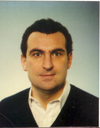|
|
|
|
|
|
|
|
| Keynote
Lecture 1 |
| Combining
Human & Machine Brains: Practical Systems in Information &
Control |
 |
|
|
| |
Prof. Kevin Warwick
University of Reading
U.K. |
|
|
|
Brief
Bio of Prof. Kevin Warwick
Kevin Warwick is a Professor of Cybernetics at the University
of Reading, UK where he carries out research in artificial intelligence,
control, robotics and cyborgs. He is also Director of the University
TTI Centre, which links the University with SME's and raises over
Ŗ2 million each year in research income.
Kevin was born in Coventry, UK and left school to join British
Telecom, at the age of 16. At 22 he took his first degree at Aston
University, followed by a PhD and research post at Imperial College,
London. He subsequently held positions at Oxford, Newcastle and
Warwick Universities before being offered the Chair at Reading,
at the age of 32.
As well as publishing over 400 research papers, Kevin has appeared,
on 3 separate occasions, in the Guinness Book of Records for his
robotics and Cyborg achievements. His paperback 'In the Mind of
the Machine' considered the possibility of machines in the future
being more intelligent than humans. His recent Cyborg experiments
however led to him being featured as the cover story on the US
magazine, 'Wired'. Kevin has been awarded higher doctorates both
by Imperial College and the Czech Academy of Sciences, Prague.
He was presented with The Future of Health Technology Award in
MIT and was made an Honorary Member of the Academy of Sciences,
St. Petersburg. In 2000 Kevin presented the Royal Institution
Christmas Lectures, entitled "The Rise of the Robots".
Abstract:
In this paper a look is taken at how the use of implant technology
can be used to either increase the range of the abilities of a
human and/or diminish the effects of a neural illness, such as
Parkinson's Disease. The key element is the need for a clear interface
linking the human brain directly with a computer. The area of
interest here is the use of implant technology, particularly where
a connection is made between technology and the human brain and/or
nervous system. Pilot tests and experimentation are invariably
carried out apriori to investigate the eventual possibilities
before human subjects are themselves involved. Some of the more
pertinent animal studies are discussed here. The paper goes on
to describe human experimentation, in particular that carried
out by the author himself, which led to him receiving a neural
implant which linked his nervous system bi-directionally with
the internet. With this in place neural signals were transmitted
to various technological devices to directly control them. In
particular, feedback to the brain was obtained from the fingertips
of a robot hand and ultrasonic (extra) sensory input. A view is
taken as to the prospects for the future, both in the near term
as a therapeutic device and in the long term as a form of enhancement.
|
|
| Keynote
Lecture 2 |
| External
and Internal Autonomy in Software Systems |
 |
|
|
| |
Prof. Erik Sandewall
Linköping University
Sweden
|
|
|
|
Brief
Bio of Prof. Erik Sandewall
Erik Sandewall is professor of computer science at Linköping University,
Sweden, since 1975. His research activities are in two areas:
first, artificial intelligence methods for cognitive robotics
and their use in systems for human-computer and human-robot interaction
and, secondly, new methods for communication of scientific results,
including electronic publication.
Erik Sandewall is the director of WITAS, the Wallenberg Laboratory
for Information Technology and Autonomous Systems. He is also
Co-Editor-in-Chief (together with Ray Perrault) of the Artificial
Intelligence Journal, General Editor of the Electronic Transactions
on Artificial Intelligence, and Director of Linköping University
Electronic Press.
Abstract:
The talk is both about 'external autonomy' where the software
systems operates as a kind of robot vis-a-vis its environment
and is autonomous in that respect, and 'internal autonomy' where
it is able to modify its own structure - essentially, learning
based on experience from the environment. |
|
| Keynote
Lecture 3 |
| Robot
perception for navigation in indoor buildings |
 |
|
|
| |
Dr. Alberto Sanfeliu
Institute of Robotics and Industrial Informatics, Technical University
of Catalonia
Spain |
|
|
|
Brief
Bio of Dr. Alberto Sanfeliu
Alberto Sanfeliu received the BSEE and PhD degrees from the Universitat
Politčcnica de Catalunya in 1978 and 1982, respectively. From
1979 to 1981, he was visiting researcher at Purdue University's
K.S. Fu Lab. He joined the faculty of the UPC in 1981, and is
since 1984, Professor with the Departament d'Enginyeria de Sistemes,
Automātica i Informātica Industrial. From 1975 to 1995 he was
a researcher at the Institut de Cibernčtica, and in 1997, he moved
to the Institut de Robōtica i Informātica Industrial. His current
research areas are Pattern Recognition, Computer Vision, and Robotics.
Dr. Sanfeliu received in 1986 the Technology Award from the Catalonian
Goverment. He has been scientific coordinator of numerous research
projects in Europe, including the MUVI project, presented to the
European Parliament in 1993. In 2000 he co-chaired the ICPR. He
is past president of the Spanish Association for Pattern Recognition
and Image Analysis 1984-2001, and of the IAPR SSPR TC. He is Fellow
of IAPR. |
|
| Keynote
Lecture 4 |
| Redundancy:
A Measurement Crossing Cutting-edge Technologies |
 |
|
|
| |
Dr. Paolo Rocchi
IBM, ITS Research and Development
Italy |
|
|
|
Brief
Bio of Dr. Paolo Rocchi
Paolo Rocchi received the degree in Physics at the University
of Rome in 1969. He worked in the same University in 1970, then
he entered IBM. He is still working as docent and researcher in
the same company. Rocchi has been a pioneer in the applications
on natual language processing and linguistic computing. In the
eighties he started an ample plan of investigations upon the foundations
of computer science that has produced stimulating outcomes in
various directions such as the reliability theory, the coding
theory, software methodologies, the probability calculus, didactics.
Rocchi's scientific production has been appreciated even beyond
the scientific community. He has received three prizes from IBM
for his publications (1978, 1999, 1992) and has a biographical
entry in Who's Who in the World (2002, 2004).
Abstract:
Information technology, robotics, automatic control and other
leading sectors deal with redundant components that pursue very
different scopes and yield a number of parameters that appear
rather heterogeneous and inconsistent from the mathematical viewpoint.
Redundant solutions are to be compared in software applications
and this variety causes the need for the unified calculus. The
talk puts forward a simple definition which leads to the various
measurements in use nowadays. The present proposal also enhances
the progress toward exhaustive understanding of the redundancy
due to the discussion of the logical origins of this quantity.
|
|
| Keynote
Lecture 5 |
| Hybrid
Dynamic Systems: overview and state of the art |
 |
|
|
| |
Prof. Janan Zaytoon
CReSTIC, URCA
France |
|
|
|
Brief
Bio of Prof. Janan Zaytoon
Janan Zaytoon received the PhD degree from the National Institute
of Applied Sciences (INSA) of Lyon, France in 1993. From 1993
to 1997 he was an assistant professor, and since 1997 he has been
a Professor at the University of Reims Champagne-Ardenne. He is
the Director of the CReSTIC Research Centre of the University
of Reims, the Deputy-Director of French GDR MACS of CNRS, the
leader of the French national group on hybrid dynamical systems,
the Chairman of the IFAC French National Member Organizer, and
the Co-Chair of the IFAC Technical Committee on Discrete Event
and Hybrid Systems.
Janan Zaytoon has published more than 150 journal papers, books,
book chapters, and communications in international conferences.
His main research interests are in the fields of Discrete Event
Systems and Hybrid Dynamical Systems. He is the Chair (or Co-Chair)
of 7 international conferences, 6 of which are IFAC events, 2
national conferences and 1 International School. He is also an
Associate Editor of Control Engineering Practice, the Keynote
speaker for 3 conferences, and the Guest Editor for 8 special
issues on Discrete Event Systems and/or Hybrid Dynamical Systems
in the following journals : Control Engineering Practice (2),
Discrete Event Dynamic Systems, European Journal of Automation,
JESA (3), e-STA, and "Revue d'Elecrtronique et d'Electrotechnique".
Abstract:
The development of systematic methods for efficient and realiable
realisation of hybrid systems is a key issue in industrial information
and control technology and is therefore currently of high interest
in many application domains. The engineering methods for hybrid
systems should deal with issues related to modelling, specification,
analysis, verification, control synthesis, and implementation.
The aim of this lecture is to present an overview and a state-of-the-art
related to hybrid systems. |
|
| Keynote
Lecture 6 |
| Convergence
of Smart Sensors, Sensor Networks and Information Processing |
 |
|
|
| |
Prof. Palaniswamy
University of Melbourne
Australia |
|
|
|
Brief
Bio of Prof. Palaniswamy
Marimuthu Palaniswami obtained his B.E. (Hons) from the University
of Madras, M.Eng. Sc. from the University of Melbourne, and PhD
from the University of Newcastle, Australia. He is an Associate
Professor at the University of Melbourne, Australia.
His research interests are the fields of computational intelligence,
Nonlinear Dynamics, and Bio-Medical engineering.
He has published more than 150 papers in these topics. He was
an Associate Editor of the IEEE Trans. on Neural Networks and
is on the editorial board of a few computing and electrical engineering
journals. He served as a Technical Program Co-chair for the IEEE
International Conference on Neural Networks, 1995 and was on the
programme committees of a number of internal conferences including
IEEE Workshops on Emerging Technologies and Factory Automation,
Australian Conferences on Neural Networks, IEEE Australia-New
Zealand Conferences on Intelligent Information Processing Systems.
He has given invited tutorials in conferences such as International
Joint Conference on Neural Networks, 2000, 2001, and is invited
to be tutorial speaker for the World Conference on Computational
Intelligence. He has also given a number of keynote talks in major
international conferences mainly in the areas of computational
intelligence, computer vision and Biomedical Engineering. He has
completed several industry sponsored projects for National Australia
Bank, ANZ Bank, MelbIT, Broken Hill Propriety Limited, Defence
Science an Technology Organization, Integrated Control Systems
Pty Ltd, and Signal Processing Associates Pty Ltd.
He also received several ARCs, APA(I)s, ATERBS, DITARD and DIST
grants for both fundamental and applied projects. He was a recipient
of foreign specialist award from the Ministry of Education, Japan.
Abstract:
In the recent times, there has been a phenomenal growth in the
advancement of smart sensors with computation, storage and transceiver
capabilities. These networked smart sensors, integrated with fast
Internet unleash tremendous opportunities of pervasive computing,
visualization and integration with its physical world. In this
talk, interdisciplinary challenges (from Biology to Mathematics)
and advances with real world examples will be presented. |
|